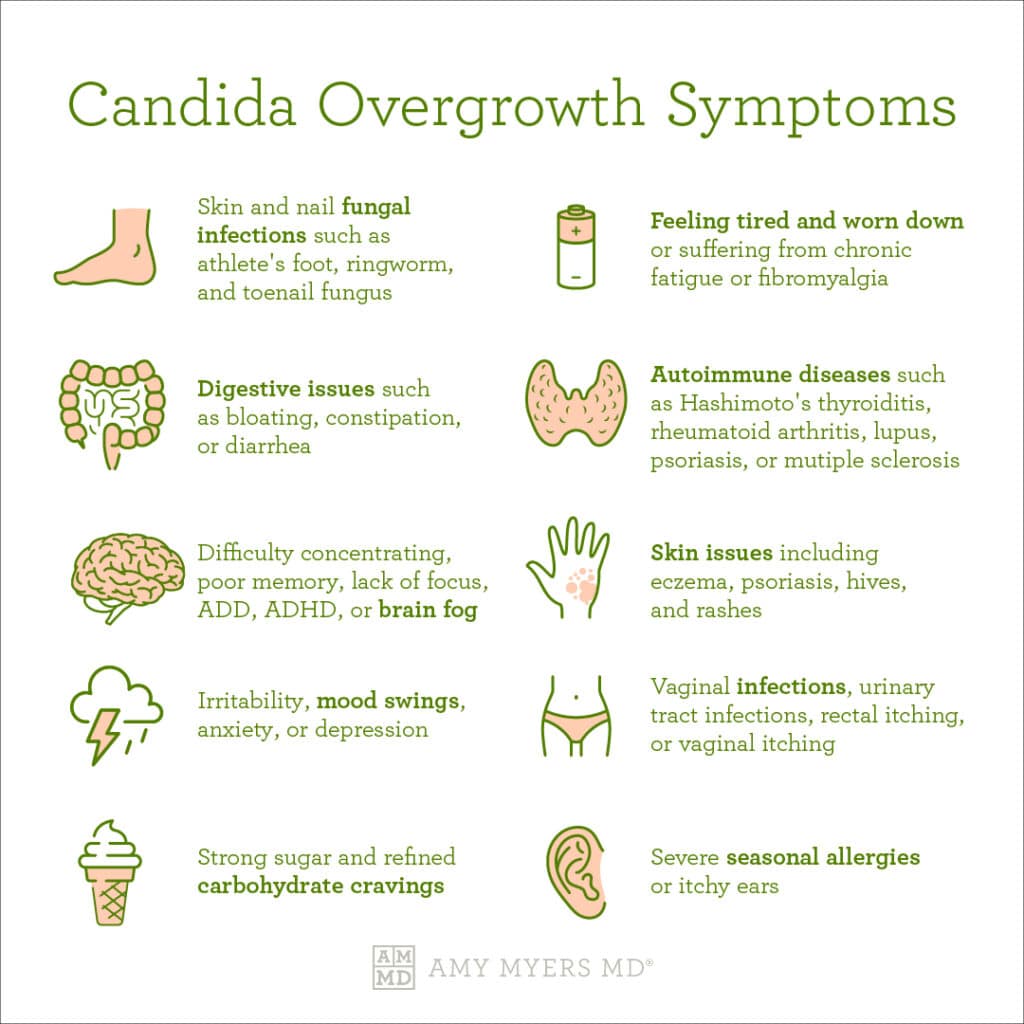Candida, a yeast infection caused by the overgrowth of Candida yeast, can present a variety of symptoms. Most people think of Candida or yeast infections being close to the crotch region, but this isn’t the only sign of a yeast infection. There are other topical and visual signs as well, but also signs and symptoms that aren’t so obvious that are worth paying attention to.
If you have any of these signs or symptoms it is worth exploring what you can do in order to kill the yeast infection and get your body back into a state of homeostasis so that you’re healthy and body is functioning at optimal capacity.
5 Common Candida Signs To Be Aware Of
- Fatigue and Brain Fog: Candida overgrowth can lead to persistent fatigue, feeling drained, and difficulty concentrating. Brain fog, characterized by trouble focusing and impaired cognitive function, is also frequently reported.
- Digestive Issues: Candida can disrupt the balance of gut flora, leading to digestive problems. Symptoms may include bloating, gas, constipation, diarrhea, or recurrent abdominal discomfort.
- Recurrent Yeast Infections: Candida overgrowth often manifests as frequent yeast infections in women. Symptoms may include itching, burning, abnormal discharge, and discomfort in the genital area. Men can also experience genital yeast infections, although less commonly.
- Oral Thrush: Candida can cause a condition called oral thrush, characterized by the presence of white patches in the mouth and throat, especially a white coat on the tongue. It can be accompanied by a cotton-like sensation, difficulty swallowing, and altered taste perception.
- Skin and Nail Issues: Candida overgrowth may result in skin problems like rashes, redness, itching, or persistent fungal infections like athlete’s foot. Additionally, nails affected by candida may become brittle, discolored, and prone to fungal nail infections. Your nails will turn yellow or even a darker brown or black. This is a sure sign of a Candida fungal infection.Other Candida Symptoms To Watch Out For:

How To Kill Candida And Restore Gut Health
In today’s world, our dietary choices greatly impact our overall well-being. One aspect to consider is the consumption of sugar, which has been linked to various health issues, including candida overgrowth. In this article, we will explore the importance of avoiding sugar and highlight twelve anti-fungal botanicals that can be incorporated into your diet to promote overall health and combat candida.
The Perils of Sugar: Excessive sugar consumption has been associated with numerous health concerns, including weight gain, diabetes, and cardiovascular problems. Moreover, sugar can contribute to the growth of Candida, a type of yeast that naturally resides in our bodies. When Candida overgrows, it can lead to an imbalance in the gut microbiota, causing candida-related infections and other health complications.
A Sugar-Free Diet for Candida Control: To address candida overgrowth, it is crucial to adopt a sugar-free diet. This means reducing or eliminating refined sugars, sugary beverages, processed foods, and even natural sweeteners like honey or maple syrup. By depriving Candida of its primary energy source, a sugar-free diet helps to create an unfavorable environment for its growth.
12 Anti-Fungal Botanicals to Include in Your Diet:
In addition to a sugar-free diet, incorporating certain anti-fungal botanicals into your meals can help combat candida overgrowth. These botanicals possess natural compounds that exhibit anti-fungal properties. Let’s explore twelve noteworthy options:
- Garlic (Allium sativum): Garlic contains allicin, a compound known for its anti-fungal effects. Incorporating fresh garlic into your meals can help combat candida.
- Tea Tree Oil (Melaleuca alternifolia): Tea tree oil is renowned for its antifungal properties, making it a valuable addition to your anti-candida regimen. Diluted tea tree oil can be used topically or added to skincare products. This is only a topical solution however, do NOT ingest this.
- Oregano (Origanum vulgare): Oregano oil, rich in compounds like carvacrol and thymol, has demonstrated potent anti-fungal activity against Candida. Adding oregano to your dishes or using oregano oil can aid in candida control. This may be one of the strongest anti-fungal, anti-candida agents found in nature and is a must in your routine.
- Pau d’Arco (Tabebuia impetiginosa): Derived from the inner bark of a South American tree, pau d’arco contains lapachol, a compound with potential anti-fungal properties. Pau d’arco tea or capsules can be incorporated into your routine.
- Grapefruit Seed Extract (Citrus paradisi): Grapefruit seed extract has been studied for its anti-fungal effects against Candida species. It can be used as a natural preservative or added to water as a throat gargle.
- Clove (Syzygium aromaticum): Clove essential oil, containing eugenol, has shown anti-fungal properties against Candida. It can be used in cooking or diluted for topical application. This is also great for the gums, teeth and dental health. It freshens the breath and happens to be the second highest rated ORAC antioxidant in the world which is valuable for preventing the aging of cells, DNA and the body as a whole.
- Neem (Azadirachta indica): Neem extracts and oils have been traditionally used for their anti-fungal effects. Incorporating neem tea or neem oil into your routine may help in combating candida. Neem is one of the staple botanicals used in Ayurvedic medicine and is also a strong blood purifier, which is a great detoxifying agent.
- Thyme (Thymus vulgaris): Thyme essential oil, with its high content of thymol and carvacrol, exhibits potent anti-fungal properties against Candida. Including thyme in your cooking or using thyme oil can be beneficial. This culinary herb is also great for the health of the lungs.
- Berberine-containing Herbs (e.g., Goldenseal, Barberry): Berberine, found in herbs like goldenseal and barberry, has been studied for its anti-fungal properties against Candida. These herbs can be consumed as extracts or in supplement form.
- Ginger (Zingiber officinale): Ginger has demonstrated potential anti-fungal effects against Candida. Adding fresh ginger to meals, brewing ginger tea, or using ginger in cooking can be helpful in controlling candida overgrowth.
- Cedar (Cedrus spp.): Cedar, derived from various species of Cedrus, has demonstrated anti-fungal properties. Cedarwood essential oil, obtained from the wood of the cedar tree, has been used traditionally for its antimicrobial effects.
- Una de Gato (Cat’s Claw): Una de Gato, also known as Cat’s Claw, is a woody vine native to the Amazon rainforest. It contains active compounds like oxindole alkaloids, which exhibit anti-fungal and immune-stimulating properties. It has been studied for its potential in supporting the immune system and combating candida overgrowth.
- Sangre de grado is a resin derived from certain Amazonian trees. It possesses several active compounds that contribute to its potential anti-fungal properties. These include:Proanthocyanidins: Sangre de grado contains proanthocyanidins, which are plant compounds known for their antimicrobial and anti-fungal effects. They help inhibit the growth of various fungal strains by disrupting their cellular processes. Taspine: Taspine is a unique alkaloid found in sangre de grado. It has shown anti-fungal properties against certain fungal species. Taspine is believed to interfere with the growth and development of fungi, inhibiting their ability to spread and cause infections.
- Cinnamon: Cinnamon is a popular spice derived from the bark of trees belonging to the Cinnamomum genus. It has been used traditionally for its medicinal properties, including its anti-fungal effects. The active components responsible for its anti-fungal activity include: Cinnamaldehyde: Cinnamaldehyde is the main bioactive compound in cinnamon, responsible for its distinct flavor and aroma. It exhibits potent anti-fungal properties, inhibiting the growth and proliferation of various fungal species. Eugenol: Cinnamon also contains eugenol, a compound with broad-spectrum antimicrobial properties. Eugenol has been found to possess anti-fungal activity, making cinnamon effective against several types of fungi.
Building a Candida-Friendly Diet: Eliminating sugar and incorporating these twelve anti-fungal botanicals into your diet forms the foundation of a candida-friendly eating plan. Focus on consuming whole foods, including vegetables, lean proteins, healthy fats, and complex carbohydrates. These dietary choices provide essential nutrients while depriving Candida of its preferred fuel source.
The Ultimate Candida Solution:
Eight of the twelve plants above (66% of the anti-fungal/anti-candida listed in this article) are contained within the Radiate 21 formula. This formula was carefully crafted to the restore the health of the gut lining, lymphatic system and body as a whole. The great thing about this formula is that it’s a liquid capsule. This melts in your mouth and you’ll be able to see and feel a difference quickly as it is a very strong, very potent formula. Learn more at Radiate21.com.
You simply take two of these capsules daily and the majority of the ingredients will work to fight this fungal infection and help get your body in order and your gut harmonized. You’ll notice a reduction of Candida symptoms while on this formula. Click here to visit Radiate21.com and grab a few bottles to kill this infection off.
Moreover, emphasize gut health by incorporating probiotic-rich foods like yogurt, sauerkraut, and kefir into your diet. Probiotics promote a healthy balance of gut bacteria, which is crucial for candida control. If you want to learn how to make these from scratch visit FermentationMethod.com to create your own probiotic foods and drinks from home. This will increase the quality of these foods and drinks while making it more economical for you.
Conclusion: A sugar-free diet combined with the inclusion of twelve powerful anti-fungal botanicals provides a potent approach to combat candida overgrowth. By avoiding sugar and embracing these natural remedies, including cedar and una de gato, you can create an environment that discourages candida growth and promotes overall health and well-being.






